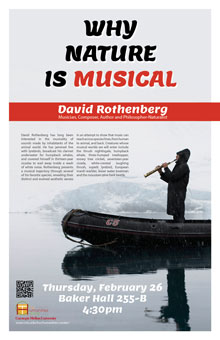Why Nature is Musical

 David Rothenberg has long been interested in the musicality of sounds made by inhabitants of the animal world. He has jammed live with lyrebirds, broadcast his clarinet underwater for humpback whales, and covered himself in thirteen-year cicadas to wail away inside a wash of white noise. Rothenberg presents a musical trajectory through several of his favorite species, revealing their distinct and evolved aesthetic senses in an attempt to show that music can reach across species lines, from human to animal, and back. Creatures whose musical worlds we will enter include the thrush nightingale, humpback whale, three-humped treehopper, snowy tree cricket, seventeen-year cicada, white-crested laughing thrush, superb lyrebird, European marsh warbler, lesser water boatman and the mountain pine bark beetle.
David Rothenberg has long been interested in the musicality of sounds made by inhabitants of the animal world. He has jammed live with lyrebirds, broadcast his clarinet underwater for humpback whales, and covered himself in thirteen-year cicadas to wail away inside a wash of white noise. Rothenberg presents a musical trajectory through several of his favorite species, revealing their distinct and evolved aesthetic senses in an attempt to show that music can reach across species lines, from human to animal, and back. Creatures whose musical worlds we will enter include the thrush nightingale, humpback whale, three-humped treehopper, snowy tree cricket, seventeen-year cicada, white-crested laughing thrush, superb lyrebird, European marsh warbler, lesser water boatman and the mountain pine bark beetle.
David Rothenberg has written and performed on the relationship between humanity and nature for many years. He is the author of Why Birds Sing, on making music with birds, also published in England, Italy, Spain, Taiwan, China, Korea, and Germany. It was turned into a feature length BBC TV documentary. His following book, Thousand Mile Song, is on making music with whales. It was turned into a film for French television. As a composer and jazz clarinetist, Rothenberg has eleven CDs out under his own name, including On the Cliffs of the Heart, named one of the top ten CDs by Jazziz Magazine in 1995 and a record on ECM with Marilyn Crispell, One Dark Night I Left My Silent House.
